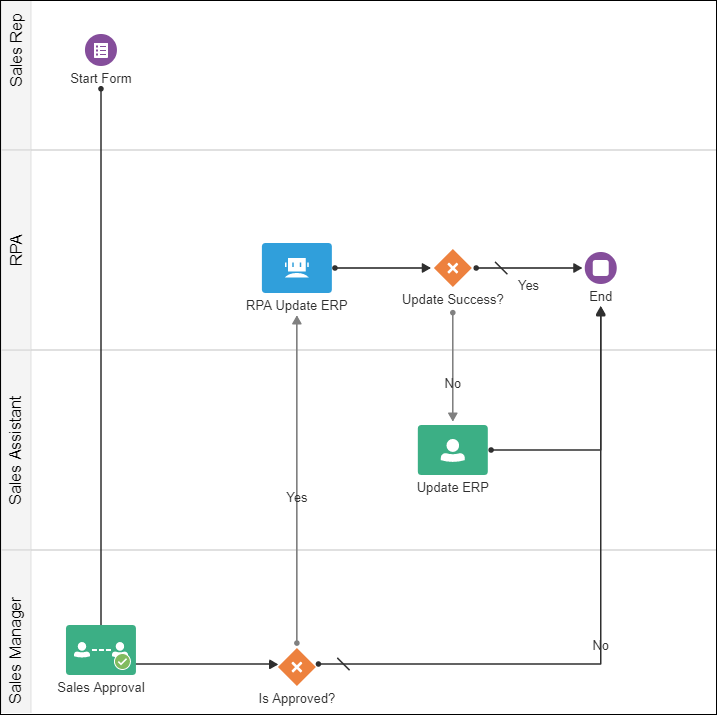Accelerate Process Automation
If your company uses legacy ERP or CRM systems (systems that don't have an adapter in Oracle Integration and don't expose APIs), you can use the Automation Anywhere RPA adapter to extend your process automation capabilities to these systems and eliminate repetitive, error-prone tasks of manually updating them, each time there’s a new order or change in customer data.
Let’s consider a simple example to illustrate how you can leverage the Automation Anywhere RPA adapter to accelerate process automation, mitigate risks, and yet retain full control of your processes.
The following figure shows an example sales process in an organization with a legacy ERP application. To begin with, a sales representative initiates a request to sell a certain item that's under controlled availability (for example, a new line of laptops) to a customer. The representative provides all the required information about the customer and the order through a web form. This request is then forwarded to a sales manager for approval. If approved, a human task is initiated to update the order details in the ERP system. Now, a sales assistant performs a set of repetitive tasks to update the ERP application, such as logging into the application, navigating screens, moving files, copying and pasting data between applications, and so on.

Description of the illustration rpa-usecase1.png
In a large organization that receives hundreds of sales requests in a day, manually updating the ERP and several other legacy systems can create a huge backlog and cause significant delays in order processing, which may ultimately result in loss of sales opportunities. Additionally, these manual tasks could potentially introduce processing errors into the system.
Using Automation Anywhere, you can create bots to automate such repetitive manual tasks. Through an Automation Anywhere Client installed on a machine, you can connect to the Automation Anywhere Control Room, which is a web-based platform where bots are deployed and bot-queue associations are defined; you can connect to the Control Room either as a Bot Creator or Bot Runner. As a Bot Creator on the Client, you'll be able to create bots that record screen actions, such as logging into applications, navigating screens, copy-pasting data, and so on. Finally, you can upload the bots to the Control Room. Subsequently, from the Control Room, you can replay these bots on the required devices (that is, Client machines registered as Bot Runners) and also use different input parameters for each run.
You can trigger these bots at any stage of an Oracle Integration process using the Automation Anywhere RPA adapter. Use the RPA adapter in Oracle Integration to create a connection to the Control Room. Then use this connection to create an integration to Automation Anywhere by specifying the type of bot to execute and the corresponding details. See Automation Anywhere Documentation and Create Integrations in Using Integrations in Oracle Integration Generation 2.
Within your process in Oracle Integration, you can use the Automation Anywhere RPA integration through a Bot Activity. In the example discussed here, you can replace the human task of updating the ERP system with a Bot Activity, and map this activity to an activated RPA integration. See Work with Bot Activities in Using Processes in Oracle Integration Generation 2.
In addition, when an Automation Anywhere bot finishes its execution, you can bring the flow back to the process in Oracle Integration and maintain complete control of your business workflow. You can also introduce a backup flow for review or escalations, in case of exceptions or errors encountered while executing bots. Thus, you can combine Automation Anywhere RPA with Oracle Integration to create highly-efficient and reliable end-to-end process automation, thereby boosting workforce productivity and customer service.
